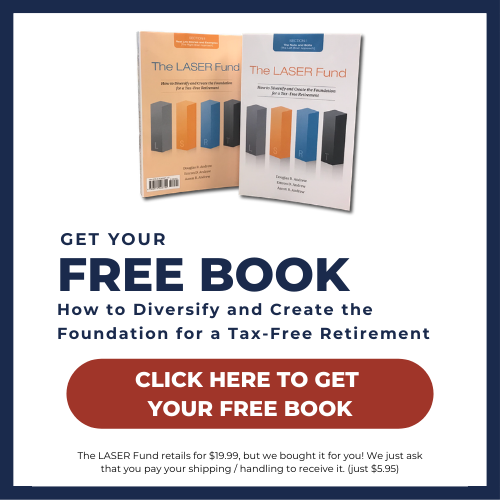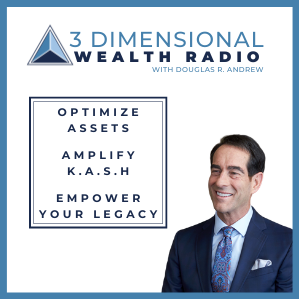What is infinite banking–and how can this concept make a difference in your financial future?
When financial strategists use the term infinite banking, they are often referring to what you can do by leveraging either Whole Life or Indexed Universal Life insurance. But here’s a newsflash: IUL insurance dwarfs Whole Life when it comes to this concept.
LET’S START WITH TERM LIFE
To explain, let’s start with a little background on life insurance, beginning with Term insurance (where policyholders simply pay for the pure cost of the insurance). Their premium is based on the mortality table, taking into consideration their age, health, etc.
Typically, Term insurance does not accumulate cash, and so the only way to “win” with Term insurance is to die. When you pass away, the policy pays out a death benefit, making Term insurance an inexpensive way to insure yourself and provide for your beneficiaries. However, Term Insurance gets more expensive as you get older.
UNDERSTANDING WHOLE LIFE
Whole Life insurance developed as an alternative to the rising-as-you-age costs of Term insurance. Essentially, people wanted to have insurance protection for their “whole life,” but they didn’t want to keep paying higher premiums every year. They realized that when they’re 60, 70, 80 years-old, they may not be able to afford Term’s increasing premiums.
Whole Life insurance basically lays it out like this: If you pay a higher premium in the early years, you may be overpaying early on, but that will allow you to underpay later on. The higher premiums build your policy’s cash value, and that cash value basically covers you for your “whole life.” Your cash value is earning interest inside the Whole Life policy, which allows you to pay a level premium your entire life. Whole Life also includes guarantees–since the 1980s, Whole Life was built on a chassis that was based upon a 4% guaranteed fixed interest rate.
Whole Life has its merits, because it’s structured to be able to give those guarantees, but in a low interest environment like we experienced during the pandemic, the Fed and U.S. Treasuries rates were under 1%.
You might wonder how insurance companies could continue to cover Whole Life policyholders for 4% when they’re not able to earn 4%. Well, the low-interest environment was putting insurance companies into a bind, and that’s why at the very end of the 2020, as part of that big stimulus legislation, Congress passed changes to Section 7702 of the Internal Revenue Code.
Basically, that legislation will likely take Whole Life’s guarantee down to 2%. So the guarantees inside of Whole Life are not going to mean that much anymore. Whole Life Insurance is going to have to perform based upon dividends and interest.
Here’s where the good news comes in: I can prove to you that Indexed Universal Life can knock the socks off Whole Life when it comes to historical rates of return. What’s more, if you’re using life insurance for infinite banking, Indexed Universal Life can top what Whole Life Insurance can do.
If all you want is death benefit, Whole Life’s a pretty good product (however, Universal Life can do well on death benefits, too). That said, there are a lot of people out there who tout Whole Life as better than IUL, and they usually quote the guarantees. But with the anticipated changes, that’s all changing.
As this evolves, you’re going to want to stay abreast of things to see how you can benefit yourself and understand how properly structured, maximum-funded Indexed Universal Life (what I call The IUL LASER Fund) is by far the best vehicle for accumulating tax-free capital.
EXPLORING IUL
With the IUL structuring strategies I recommend, most people are self-insured within 10 to 15 years, meaning the cash inside the insurance policy is within 5% of the death benefit within 15 years–so the cost of the insurance is next to nothing.
To explain, let’s say you put $500,000 into your IUL policy, and the amount of insurance required for it to be tax-free for a 60-year-old is 1,250,000. Based on historical rates of return, that 500,000 can grow to $1 million within seven to 10 years, and in another seven to 10 years, it can grow to $2 million.
That’s more than the insurance, so from this point on, the insurance can stay ahead of it by five percentage points. Indexed Universal Life is by far the cheapest insurance policy when it’s structured properly because it gets cheaper as you get older. You don’t need guarantees, because the cash value can equal or almost equal the death benefit, based upon the TEFRA/DEFRA tax citations.
Tax citations including TEFRA, DEFRA, and TAMRA and Internal Revenue Code Sections 72E, 7702, and 101A make all of this possible. They essentially say that when you put money into an insurance policy and you take the least amount of insurance the IRS will allow, you can accumulate your money tax-free, access your money tax-free, and when you die, your money blossoms and transfers income-tax-free as a death benefit to your beneficiaries.
As far as I’m aware, nothing else does that in the Internal Revenue Code. IUL LASER Funds are where I have personally earned average rates of return of 6%, 8%, 10%. I’m talking about net internal rate of return cash on cash.
HOW IT ALL PLAYS INTO INFINITE BANKING
Now, let’s get to how properly structured, maximum-funded IUL policies can power your infinite banking, setting you up to perpetually act as your own banker.
Let’s say you have a business venture coming up. You could borrow from the bank–or you can borrow from yourself. With your IUL policy, you can access capital from your policy tax-free via an Alternate Loan.
You might be borrowing at one rate, while your money is still in the policy potentially earning a higher rate. You can earn a spread on the money you’re borrowing, making it possible to pursue the business venture, while your money is still at work in the policy.
This same be-your-own-banker principle applies to other needs you might have–retirement income, educational expenses for your children or grandchildren, emergency funds, etc.
Whole Life Insurance oft times has been touted for infinite banking because when you build up cash value, you can likewise borrow money out of your Whole Life policy, and the insurance company will charge you a nominal interest rate, and then they’ll keep crediting you a little bit higher interest rate.
If you borrowed at 2%, let’s say, you might be guaranteed 4%, so you’re being guaranteed twice as much as they’re charging you, which is good.
But all Whole Life proponents have ever been able to say is, “Well, Universal Life doesn’t have the guarantees Whole Life has.” True, properly structured IUL policies don’t have guaranteed rates of return, but your money can be LINKED TO indexes like the S&P 500, which has historically delivered 5% to 10% returns. And in down years, your principal is protected by a 0% floor. And now that Whole Life guarantees are likely going down to 2%, the “4% guarantee” is not so much a factor anymore.
COMPARING INFINITE BANKING PERFORMANCE
To illustrate the difference between insurance types, let’s say I have a policy from which I’ll borrow $1 million. If it were a Whole Life policy, I could borrow that and they will credit me a little bit higher interest rate, and I’m paying myself interest as I put money back into the policy. If I borrow at 2% and I earn 4%, 4% is 100 times more than 2%. I get it; that sounds pretty good. But with the legislation, those guarantees are likely going down.
With IUL, I opt for the Alternate Loan. This is where the insurance company goes, “Well, you can leave your money with us as collateral, and we’ll keep crediting you whatever the index that you’re linked to is earning.”
Although my personal experience is not a guarantee of others’ experiences, with my policies’ index strategies, I’ve earned 10%, 16%, 25%, even 55%. Some years I don’t earn that, but the average has been between 8% and 10%.
So as an illustration, let’s keep it simple and say my policy is earning 10%. With my Alternate Loan, the insurance company is going to charge me, let’s say 5%. So on that $1 million I borrowed, they’re going to charge $50,000.
If I earn 10% on my $1 million that is still sitting in the policy (being used as collateral for the loan), and they charge me 5%, I’m earning 100% more than the cost of the funds. So I’m earning $50,000. This is way better than a measly little 2% maybe in a Whole Life policy.
I have had many clients, who for their real estate management, borrowed money to build or to buy real estate properties. They have borrowed that money at 5%, and they have earned sometimes 16%, 25%, even 55% on Indexed Universal Life (again individual experiences are not guarantees of others’ policy performance).
So let’s say I borrowed $1 million from my policy in 2017, when people earned 25%. The insurance company charged me $50,000. That is deducted automatically from the 25% I earned. So they paid me $250,000 and deducted $50,000 from my cash value. I netted 20%, or $200,000.
This is like infinite banking on steroids. This is why I say Indexed Universal Life can dwarf Whole Life as far as the spread (the difference between the net cost to borrow and the net amount you’re earning on the money compounding inside the policy). And the longer it goes, your money can keep earning and growing tax-free.
Pretty soon you’re earning, let’s say, 10%, on twice as much money that you’re paying interest on. And as it grows, you can keep borrowing more money. This just keeps getting better and better as you go.
So if you’re intrigued with infinite banking, or becoming your own banker, you can see how a property structured IUL insurance policy can actually perform far better than Whole Life. I’ve had many Whole Life agents when they see the illustrations agree, “Oh my heavens, this knocks the sock off of Whole Life.”
This is where I say, “Why do something that’s good when you could do something that’s better, or even best?”
WANT TO LEARN MORE?
Watch the Video – Watch the related YouTube video to see me explain “Infinite Banking with IUL versus Whole Life” (and while you’re there, be sure to subscribe to my YouTube channel so you don’t miss a thing!).
Elevate Your Financial Dimension – Find out how you can improve your Financial Dimension journey and seize the liquidity, safety, predictable rates of return, and tax advantages of a LASER Fund. Explore the in-depth financial strategies and learn from real-life client experiences by claiming your free copy of “The LASER Fund” book at LASERFund.com. Just pay for shipping and handling, and we will send it to you, absolutely free.
Join a Webinar – Want to find out if a LASER Fund (a maximum-funded, properly structured indexed universal life insurance policy) is right for you? Join us for an upcoming webinar where you can explore these strategies.


